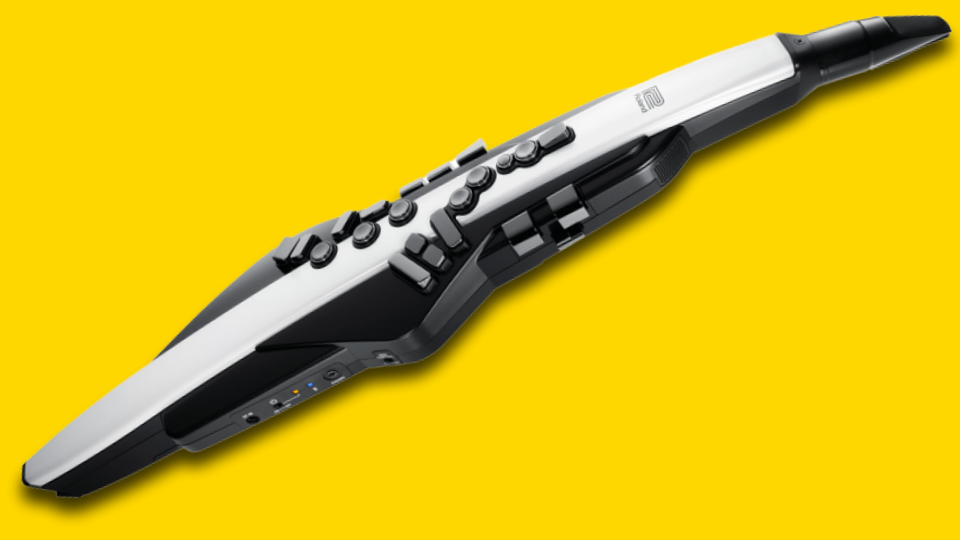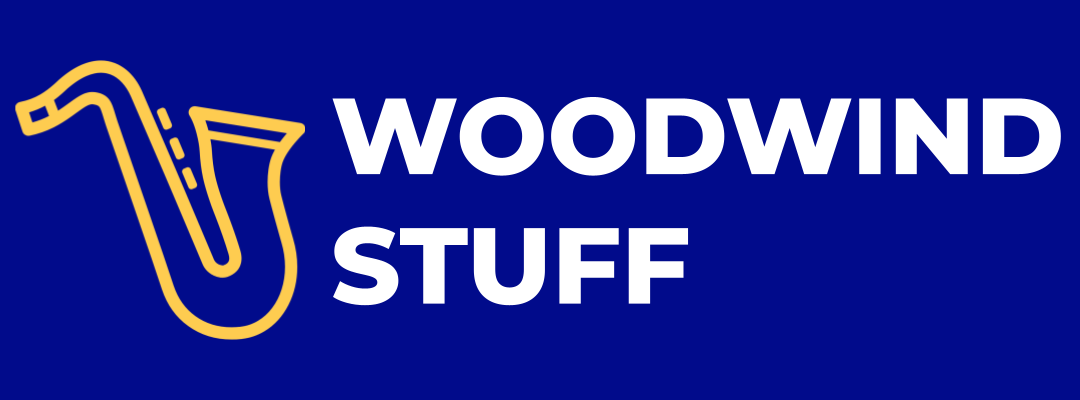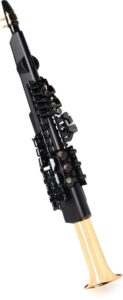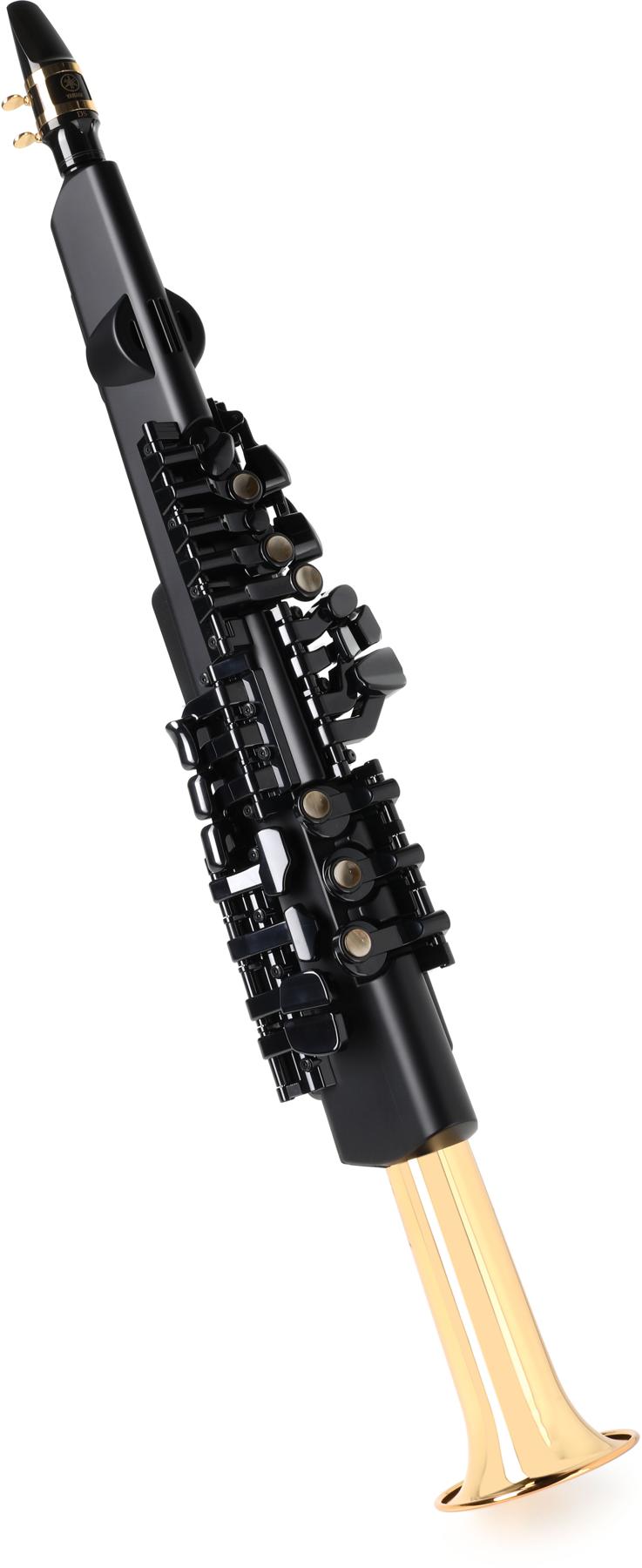Electronic wind instruments have been steadily flooding the market over the last several years. And as a sax player who primarily plays Yamaha horns, I was super excited when they originally announced the YDS-150 back in late 2020.
Fast forward a few years, and I now find the Yamaha YDS-150 disappointing compared to other wind synths. It’s wonderful as a casual instrument, but not much beyond that.
What Is the Yamaha YDS-150?
The Yamaha YDS-150 is a “digital saxophone”. In other words, it’s an electronic instrument designed to be accessible to sax players, as well as musicians who want to try a wind instrument for the first time. It comes loaded with plenty of sampled saxophone sounds, plus some electronic sounds.
It also connects to a smartphone app via Bluetooth, which you can use to modify sounds and effects, plus control other functions.
Yamaha’s digital sax feels more like real saxophone than most other wind controllers. While it won’t replace your acoustic sax, it’s a really fun casual instrument. It’s also a decent practice tool that lets you play quietly without bugging family or neighbors.
Pros:
- Perfect for casual playing
- Great for silently practicing saxophone
- Some of the best sax samples on any electronic instrument
- Keys feel good underneath the fingers
- Mouthpiece and mechanical keys give semi-authentic sax feel
Cons:
- Too many saxophone sounds
- Not enough synth sounds
- No rollers between pinky keys
- Control stick has limited use
Included Sounds
Arguably the most important aspect of any electronic wind instrument are the sounds. The YDS-150 comes loaded with 73 sounds. Doesn’t sound half bad, right?
The problem is, 56 of them are saxophone samples. That’s over 3/4 of the on-board sounds! Here’s what you get:
- 17 alto sax sounds
- 13 soprano sax sounds
- 15 tenor sax sounds
- 11 baritone sax sounds
- 5 acoustic instrument sounds (1 harmonica, 1 bagpipes, and 3 ethnic flutes)
- 12 synthesizer sounds
The most appealing thing about wind synths is being able to play electronic sounds. And I’m willing to bet that most of the 150’s target market already knows how to play saxophone. So limiting this device to mostly sax sounds is pretty baffling to me.
In fairness, Yamaha went through the trouble of sampling some of their artists to create these sounds. As a result, they’re some of the best sax samples I’ve ever heard — especially the bari sax sounds.
But for the most part, it’s difficult to get a realistic performance from these samples. Generally speaking, they’re going to sound pretty hokey.
You can sort of mask that hokeyness with the YDS-150’s built-in effects, or with some music production trickery.
Built-In Effects & Filters
Even if there isn’t much variety of sounds, the YDS-150 sort of makes up for it with its built-in effects. So it opens up a few sound design possibilities.
Here’s what you can do with it:
- Rotary
- Distortion (2 types)
- Chorus
- Flanger
- Phaser
- Tremolo
- Auto Pan
- Low Pass Filter (LPF)
- High Pass Filter (HPF)
You can modify parameters for most of these filters like the resonance peak, cutoff frequency, or depth.
That said, you can only have one of these filters on at a time. You can’t layer them on top of each other, which I wish they would have done more.
Different Fingering Systems for Customization and Accessibility
By default, the YDS-150 uses a standard saxophone fingering system. At first, I was hugely disappointed that it couldn’t do more.
But I dug into the mobile app and found out that it offers these different fingering systems:
- Standard saxophone
- 5-octave saxophone
- Trumpet
- Flute
- Clarinet
- Left hand only fingerings
- Right hand only fingerings
On top of that, you can create custom fingering sets.
I mostly use the standard sax or the 5-octave sax settings. But if you need them, the other key systems are there.
That said, be in for a shock if you’re familiar with one of those other instruments. I think the some of the clarinet fingerings are wildly questionable, especially over the break (If you know, you know).
I’m not as familiar with the trumpet or flute, but I’m willing to bet there are some equally questionable programming choices.
But all in all, I’m quite pleased to see these accessibility and customization options.
Companion Mobile App
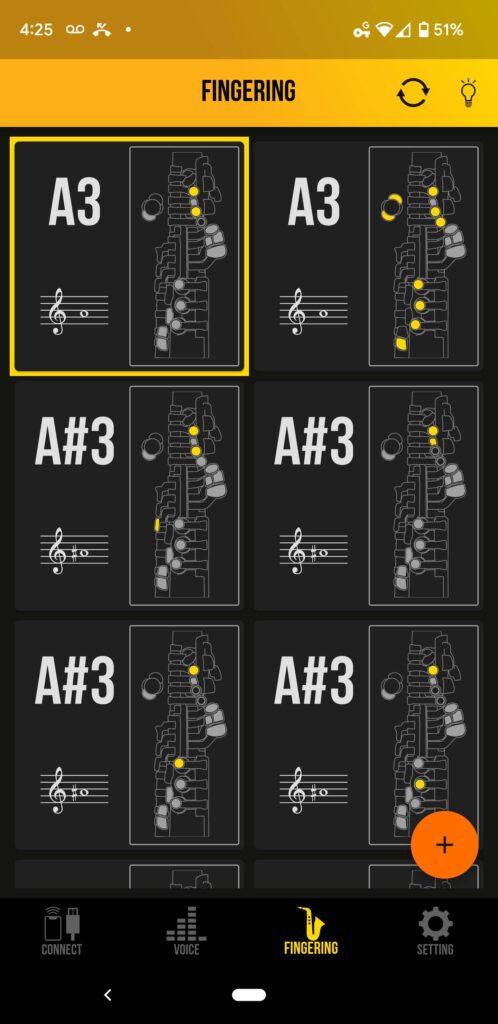
You can select sounds and change settings natively on the digital sax itself. But it requires memorizing different key and button combinations, which isn’t very intuitive.
Thankfully, you can configure all those settings with the YDS Controller app for iOS and Android. Just pair the instrument with your phone through Bluetooth, and you’re ready to go.
Here’s what you can do with the app:
- Save presets for your favorite sounds
- Change and modify the sounds and effects
- Change the fingering system and view fingering charts
- Change the instrument’s pitch and tuning
- Modify the MIDI output settings
I’d go as far as to say the app is a necessity for using the YDS-150. Without it, it’s a real hassle to control this thing.
Key Layout
Yamaha’s gone out of their way to make this instrument feel like a saxophone. One of the ways it does that is with the keys.
For starters, the key layout is based on the Yamaha Custom EX alto saxophone (at least according to a Yamaha rep I spoke with).
And even though the keys are digital, they have a mechanical action. This makes the transition from a real sax feel mostly seamless.
The keys feel really good under my fingers. Unfortunately, there aren’t any rollers between the pinky keys. This feels like Yamaha cutting corners, where they could have elevated the instrument into something truly unique among products like this.
Other reviewers say they had to press the keys “really hard” to get them to function properly. The unit I have currently doesn’t have those issues, and I had no problem getting the sax to respond to inputs. But I won’t discount their experience, either.
Sax Mouthpiece & Brass Bell
The other most distinct features are the saxophone mouthpiece and brass bell.
Mouthpiece
The mouthpiece isn’t anything special. In fact, it looks like a standard Yamaha 4C alto sax mouthpiece.
It also comes with a fake reed and a sax ligature. These don’t do anything — they’re just for comfort and feel.
You can remove the mouthpiece entirely and just blow directly into the YDS-150 itself. Alternatively, you could slap on any alto sax mouthpiece and get the same result.
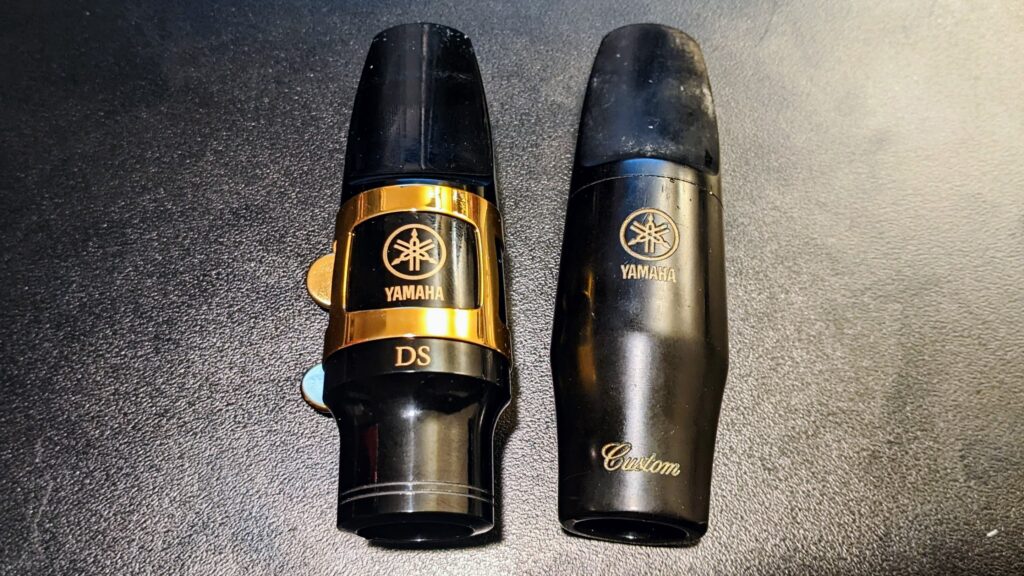
Bell
The brass bell is also a weird feature.
According to Yamaha, it can “gorgeously reproduce the long reverberation peculiar to wind instruments” and that it “causes the entire instrument to vibrate” to “let you truly feel the music as you play it.”
Maybe it’s true. But to me, it feels like marketing BS. And I say that as someone who worked in marketing for music retail.
Really, the bell’s there for aesthetic purposes. It’s also handy for displaying the instrument on a stand.
Analog Control Stick
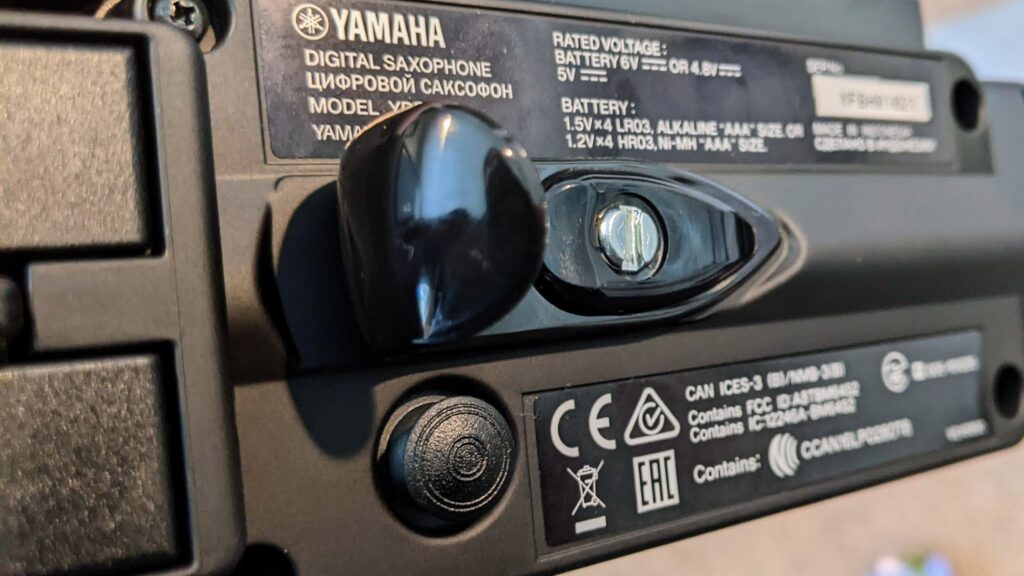
There’s a control stick down by the right thumb rest. It has three basic functions:
- Pitch Bend: Lets you bend the pitch up or down.
- Modulation: Works like the mod wheel on a synthesizer.
- Portamento: Creates a gliding effect between notes.
Pitch bend is the default function. But you can change that within the app’s settings.
I have two minor issues with the thumb stick. First, it’s awkwardly placed and hard to use in normal playing.
Second, it can only do one of the previously mentioned functions at a time. I wish you could set different functions to up/down and left/right (like with the Roland Aerophone).
It’s not the end of the world, but still something I wish was executed better.
Battery Life
The YDS-150 uses four AAA batteries. Or you can power it using a micro USB cable.
I haven’t done any formal testing on the battery life of this thing. But it only lasted me a few hours. So don’t be surprised if it suddenly dies mid-performance.
Lightweight Carrying Case
Yamaha’s digital sax comes in a lightweight carrying case. It’s a soft case with a semi-hard outer shell.
The case is handy for carrying the sax over your shoulder. Just don’t expect it to protect it from fall damage.
Recommended Accessories for the YDS-150
If you do decide to get this thing, you might want to pick up a few things to go with it.
First, I’d recommend getting some basic mouthpiece patches. Like most plastic mouthpieces, the included DS mouthpiece is incredibly prone to teeth marks. The patches will prevent that from happening. They’ll also give you a better grip on the mouthpiece and make it more comfortable to play.
Next, I’d get a better neck strap. The stock strap that comes with any Yamaha sax is pretty stiff and rigid. It could dig into your skin and be incredibly uncomfortable.
You’ll want a nice neck strap that’s cushioned. One of my favorites is the Neotech Classic Strap. It’s got a soft, gel-like cushion for your neck, and it’s the go-to strap I recommend to all my sax students.
Lastly, I’d recommend getting a display stand.
The YDS-150 won’t fit on a soprano saxophone stand. Instead, use a trumpet stand.
One of my favorite stands is this K&M trumpet stand. It has five legs, reducing the chances of your instrument tipping over. You can also fold up the legs and put the stand inside the bell during storage.
So… Who is the YDS-150 For?
I’d say that the Yamaha YDS-150 is for the following kinds of people:
- People wanting a casual instrument to mess around with, but aren’t very serious musicians.
- Former saxophone players wanting to get back into playing.
- Folks who need a quiet way to practice the saxophone without bothering their family or neighbors.
But I’d never recommend the 150 as a serious instrument for performing on stage or in a pit orchestra. You’re better off getting another MIDI wind controller.
Speaking of which…
YDS-150 Alternatives
Yamaha recently came out with the YDS-120. It’s virtually the same exact instrument, but in a smaller form factor and cheaper price tag. In my opinion, it now makes the YDS-150 obsolete.
Read More: Yamaha YDS-150 vs YDS-120: Which Is the Better Deal?
And for a similar price to the YDS-150, you can get another digital wind instruments that have more sounds and features.
Final Thoughts: Should You Buy the Yamaha YDS-150?
If you’re just looking for a fun instrument to casually play, or a good tool for quietly practicing saxophone, the Yamaha YDS-150 will do the job just fine.
In my opinion, it’s a wonderful instrument with lots of great ideas, and it comes so close to greatness. But the fact that it mostly has saxophone sounds and very few other sounds makes it hard to recommend. Especially when there are other products like it.
You won’t properly develop your embouchure and tone like you would a real sax. But at the very least, you can practice saxophone with a mouthpiece and keys that sort of feel like the real thing.
But I can’t recommend it for anyone else, especially when there are other instruments in the same price range with more sounds and features. If you’re looking for a serious performance instrument with lots of different sounds, try looking at something else.
Yamaha’s digital sax feels more like real saxophone than most other wind controllers. While it won’t replace your acoustic sax, it’s a really fun casual instrument. It’s also a decent practice tool that lets you play quietly without bugging family or neighbors.
Check Out These Other Digital Wind Instruments
The YDS-150 might be weird and slightly disappointing. But if you’re in the market for something else, you can check out these other wind controllers.
Read More: The Best Digital Wind Instruments
